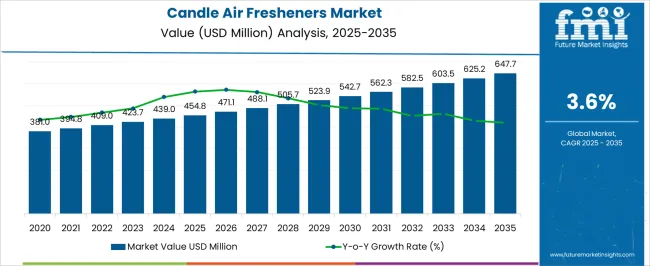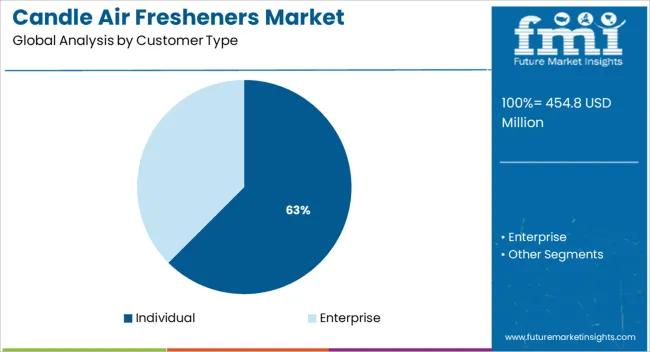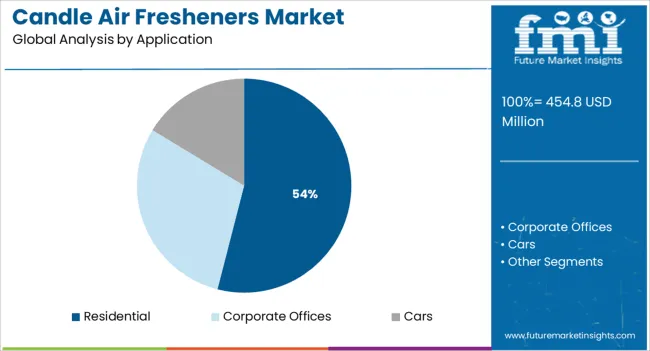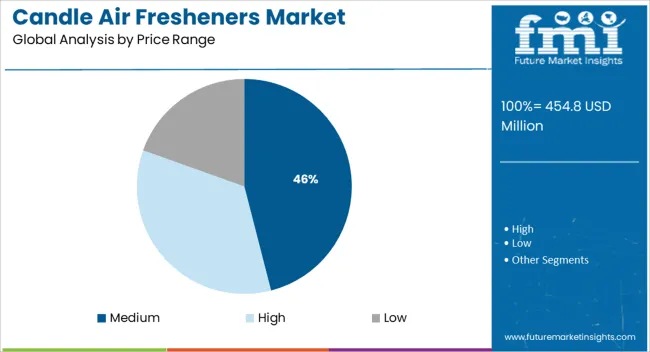The Candle Air Fresheners Market is estimated to be valued at USD 454.8 million in 2025 and is projected to reach USD 647.7 million by 2035, registering a compound annual growth rate (CAGR) of 3.6% over the forecast period.

| Metric | Value |
|---|---|
| Candle Air Fresheners Market Estimated Value in (2025 E) | USD 454.8 million |
| Candle Air Fresheners Market Forecast Value in (2035 F) | USD 647.7 million |
| Forecast CAGR (2025 to 2035) | 3.6% |
The candle air fresheners market is exhibiting steady growth as consumers increasingly seek products that combine ambient fragrance with decorative appeal. Rising awareness of indoor air quality, along with growing preference for natural and aesthetically pleasing home fragrance solutions, has elevated demand in both developed and emerging regions.
Consumer inclination toward products that offer multi-sensory experiences and align with wellness trends has reinforced market penetration. Future growth is anticipated to benefit from innovations in natural wax blends, sustainable packaging, and artisanal fragrance profiles.
Shifts in consumer lifestyles, coupled with premiumization of home care products, are paving the way for expanded adoption and enhanced brand loyalty across diverse demographic groups.
The market is segmented by Customer Type, Application, Price Range, and Sales Channel and region. By Customer Type, the market is divided into Individual and Enterprise. In terms of Application, the market is classified into Residential, Corporate Offices, and Cars. Based on Price Range, the market is segmented into Medium, High, and Low. By Sales Channel, the market is divided into Hypermarkets/ Supermarkets, Convenience Stores, Multi-brand Stores, Online Retailers, Specialty Stores, and Other Sales Channel. Regionally, the market is classified into North America, Latin America, Western Europe, Eastern Europe, Balkan & Baltic Countries, Russia & Belarus, Central Asia, East Asia, South Asia & Pacific, and the Middle East & Africa.

When segmented by customer type, the individual segment is expected to account for 62.5 % of the market revenue in 2025, maintaining its leadership position. This dominance has been shaped by the growing consumer emphasis on personalizing living spaces and enhancing mood through fragrant décor items.
Individual customers have increasingly embraced candle air fresheners for their dual functionality as decorative accents and aroma diffusers, which has elevated their appeal within households. The accessibility of a wide range of fragrances and designs has enabled individuals to select products that align with personal preferences and seasonal themes.
Additionally, heightened sensitivity toward indoor environmental quality and the emotional comfort offered by candles have further consolidated the preference among individual buyers.

Segmented by application, the residential segment is projected to contribute 54.0 % of the market revenue in 2025, securing its position as the top application segment. This prominence has been reinforced by rising consumer interest in enhancing home environments with calming and pleasant scents.
Candle air fresheners have been widely adopted in living rooms, bedrooms, and bathrooms owing to their ability to create an inviting atmosphere and mask undesirable odors effectively. The aesthetic versatility of these products, along with their compatibility with modern and traditional interiors alike, has strengthened their adoption in residential settings.
Emotional associations of candles with relaxation and self-care have further driven their integration into daily routines, sustaining the segment’s leadership.

When segmented by price range, the medium price range is anticipated to hold 46.0 % of the market revenue in 2025, positioning it as the leading segment. This leadership has been influenced by the balance it offers between quality and affordability, making it accessible to a broad consumer base without compromising on aesthetic appeal or fragrance performance.
The medium segment has been able to attract consumers who seek value for money while still expecting premium-like features, such as natural waxes, sophisticated scents, and attractive packaging.
Brands have increasingly focused on this segment to cater to middle-income households looking for indulgence at a reasonable cost, reinforcing its dominance in the competitive landscape.
Candle air fresheners do not remove pollution. Instead, they add fresh odors or fragrances that are strong enough to cover foul odors. Air fresheners can be used both indoors and outdoors.
They are made up of a complex blend of chemicals, including synthetic scents, which are among the leading causes of allergic reactions in people. Consumer products such as candle air fresheners are utilized in homes, offices, hotels, and other public places. The primary goal of using a candle air freshener is to add a pleasant scent to the environment and disguise unwanted odors. However, this benefit comes at the cost of exposure to a cocktail of chemicals released into the environment by candle air fresheners.
Rising concern about indoor air quality, combined with the growing relevance of a fresh and clean environment, is driving the global candle air freshener market. Product developments, improving lifestyles, rising population, expanding importance of aromatherapy, growing consumer disposable incomes, and improved living standards are all expected to drive the candle air freshener market forward. However, the presence of poisonous chemicals that are harmful to one's health may limit market expansion.
Companies are focusing on developing and manufacturing air fresheners using natural components such as lemons and flowers due to changing consumer preferences. Improved products to manage room odors are arising from advancements in packaging and dispersing technologies.
Candle air freshener sales are predicted to rise because of the widespread availability of a variety of product categories with appealing features. The expanding use of air freshening products such as candle air fresheners witnessed a market growth of ~2.7% between 2020 and 2024.
Innovative Advertising and Marketing Campaigns to Drive Candle Air Freshener Sales
In the coming years, the worldwide candle air fresheners market is predicted to rise at a rapid pace. The rising global demand for a variety of aromatic products is a major element driving the candle air fresheners market forward. Other factors, such as the increasing importance and popularity of aromatherapy, as well as the development of new products and fragrances, are expected to drive the global market's growth in the coming years.
Key companies' increased attention to marketing activities and advertising campaigns is likely to boost market growth during the forecast period. Furthermore, the worldwide candle air fresheners market is likely to be fueled in the coming years by the simple availability of products due to the expansion of distribution methods around the world.
On the negative side, the high cost of production is expected to stifle widespread adoption, posing a major challenge for the global candle air freshener market. Aside from that, the growing demand for high-end lifestyles and luxury in everyday life creates a profitable possibility for the widespread usage of candle air fresheners.
High Standard of Living in the USA to Propel Candle Air Freshener Demand
In the USA, the demand for air care is increasing every day, as the residing population is worried about indoor air quality. As a result, individuals are more concerned about its impact on their health. The candle air freshener market in the USA is likely to experience high consumer demand and increase at a substantial rate throughout the forecast period.
According to FMI, all of these factors are helping to drive candle air freshener sales in the USA, which are predicted to reach USD 647.7 Million by 2035.
Need for Product Modification and Customized Scent to Increase Candle Air Fresheners Sales
One of the important trends projected to promote healthy growth in this market is widespread customer awareness of the available products. To fulfill client tastes in this market, manufacturers are experimenting with perfumes in previously unheard-of ways, and consumers in this region have embraced this trend.
Candle air freshener manufacturers are diversifying their product lines in response to consumers' willingness to spend a premium price for aesthetic scents, leading to revenue growth in this region. According to Future Market Insights (FMI), the CAGR is set to be 3.6 %.
Preferences are shifting, and brands are expanding their market share by launching new products
In the Indian automotive air freshener industry, shifting preferences are an ongoing issue. Due to growing regulatory scrutiny of air fresheners, considerable variations in climatic settings, and highly individualized preferences, manufacturers are finding it next to impossible to predict consumer preferences. Many consumers, on the other hand, like to use the same air fresheners at their offices as they do at home. As a result, brands rely on surveys, online reviews, and customer feedback to forecast specific purchasing patterns.
Manufacturers are focusing on new natural smell compositions that help improve product quality, resulting in increased promotions to gain consumer loyalty. As a result, the candle air freshener industry in India is witnessing an increase in the sale of air fresheners as gifts. During the forecast period, the products’ critical applications and appealing characteristics are projected to fuel healthy growth for market participants.
Over 3/5th of Candle Air Freshener Demand to be Contributed by Residential Segment
The residential segment of the candle air freshener industry is the largest and fastest-growing with a current market share of ~65%. This figure represents an increasing trend among customers who are realizing that having a pleasant-smelling home is important all year, not only for special occasions and holiday gatherings. According to research, one out of every ten customers had a candle air freshener product in their shopping cart.
This is mainly due to favorable demographics and a global hygiene trend. The segment, on the other hand, is expected to increase at a CAGR of 3.4% over the projection period. Rising disposable income and a growing willingness among customers to spend on high-end goods are factors driving the segment
Medium Price Range Products Are More Popular Among Millennials
A mid-price strategy aims to find a balance between a strong reputation and competitive pricing. The idea is to appeal to the mass market and thus gain greater penetration, rather than targeting clients who want to spend a lot of money on products with premium pricing.
The products are not purchased by low-income groups since they are not considered necessities. As a result, low product pricing is not a consideration for players as it may not generate more demand. The category is expected to grow at a CAGR of 3.7% over the forecast period due to the aforementioned factors.
Emergence Of Modern Trade To Aid The Market Growth
Hypermarkets/supermarkets are expected to contribute significant market revenue, and this trend is projected to continue in the next years. In 2024, hypermarkets/supermarkets had around 23% of the market share in the candle air fresheners market.
Customers may choose to purchase a product after experiencing it or trying it on, reducing the risk of unhappiness. Because they can grasp goods in their hands and smell their aroma, consumers can rapidly assess product quality and provide feedback in retail locations.
The primary strategies adopted by players in the candle air freshener market are product innovations, expansions, and mergers and acquisitions. Sustained competitive advantage through innovation is the key requirement for large enterprises' market share growth around the world.
To preserve their market position, companies are increasing their Research and Development and marketing activities, as well as expanding their distribution channels.
| Attribute | Details |
|---|---|
| Estimated Market Value (2025) | USD 454.8 million |
| Projected Market Size (2035) | USD 647.7 million |
| Value-based CAGR (2025 to 2035) | 3.6% |
| Forecast Period | 2025 to 2035 |
| Historical Data Available for | 2020 to 2024 |
| Market Analysis | USD Million for Value |
| Key Regions Covered | North America; Latin America; Europe; East Asia; South Asia; Oceania & MEA |
| Key Countries Covered | United States of America, Canada, Brazil, Mexico, Germany, UK, France, Spain, Italy, Russia, Benelux, South Africa, Northern Africa GCC Countries, China, Japan, South Korea, India, Thailand, Malaysia, Indonesia, Australia & New Zealand |
| Key Segments Covered | Customer Type, Application, Sales Channel, and Region |
| Key Companies Profiled | Church & Dwight, Inc.; Farcent Enterprise Co. Ltd.; Godrej Consumer Products Limited; Henkel AG & Co. KGaA; Kobayashi Pharmaceutical Co. Ltd.; Newell Brands; Procter & Gamble; Reckitt Benckiser Group plc.; S. C. Johnson & Son, Inc.; Yankee Candles; Others |
| Report Coverage | Market Forecast, Company Share Analysis, Competition Intelligence, Drivers, Restraints, Opportunities and Threats Analysis, Market Dynamics and Challenges, and Strategic Growth Initiatives |
The global candle air fresheners market is estimated to be valued at USD 454.8 million in 2025.
The market size for the candle air fresheners market is projected to reach USD 647.7 million by 2035.
The candle air fresheners market is expected to grow at a 3.6% CAGR between 2025 and 2035.
The key product types in candle air fresheners market are individual and enterprise.
In terms of application, residential segment to command 54.0% share in the candle air fresheners market in 2025.






Full Research Suite comprises of:
Market outlook & trends analysis
Interviews & case studies
Strategic recommendations
Vendor profiles & capabilities analysis
5-year forecasts
8 regions and 60+ country-level data splits
Market segment data splits
12 months of continuous data updates
DELIVERED AS:
PDF EXCEL ONLINE
Candle Box Market Size, Share & Forecast 2025 to 2035
Candle Jar Market Growth & Industry Forecast 2025 to 2035
A Detailed Global Analysis of Brand Share for the Scented Candle Market
Scented Candlе Industry Outlook
Market Share Distribution Among Eco-Friendly Candle Manufacturers
Eco-friendly Candle Market Report – Demand & Trends 2024-2034
Mosquito Repellent Candles Market Analysis – Trends, Growth & Forecast 2025 to 2035
Airless Paint Spray System Market Size and Share Forecast Outlook 2025 to 2035
Air Caster Skids System Market Size and Share Forecast Outlook 2025 to 2035
Airborne Molecular Contamination Control Services Market Forecast and Outlook 2025 to 2035
Airflow Balancer Market Size and Share Forecast Outlook 2025 to 2035
Aircraft Cabin Environment Sensor Market Forecast and Outlook 2025 to 2035
Aircraft Flight Control System Market Size and Share Forecast Outlook 2025 to 2035
Airborne Radar Market Size and Share Forecast Outlook 2025 to 2035
Aircraft Electric Motor Market Forecast Outlook 2025 to 2035
Airport Ground Transportation Market Forecast and Outlook 2025 to 2035
Airless Sprayer Accessories Market Size and Share Forecast Outlook 2025 to 2035
Air Purge Valve Market Size and Share Forecast Outlook 2025 to 2035
Air Flow Sensors Market Size and Share Forecast Outlook 2025 to 2035
Air Separation Plant Market Size and Share Forecast Outlook 2025 to 2035

Thank you!
You will receive an email from our Business Development Manager. Please be sure to check your SPAM/JUNK folder too.
Chat With
MaRIA